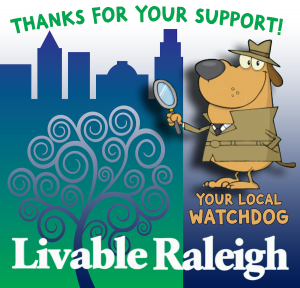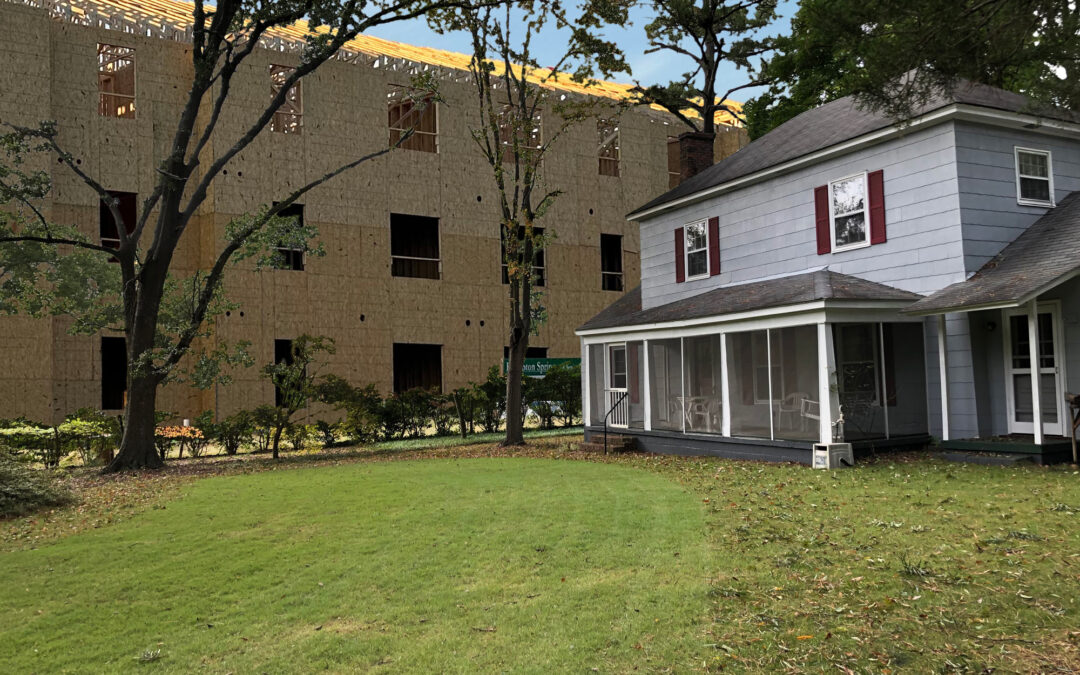
Larry King is a native of Georgia. He received his Bachelor of Mechanical Engineering degree from Georgia Tech and his MS and PhD degrees in Agronomy from the University of Georgia. In 1974 he joined the faculty of the Department of Crop and Soil Sciences at NC State University and purchased a (now) 100-year-old house in SW Raleigh. The house was the clubhouse at the Capitol Country Club golf course established in 1931. Larry served on the board of the Women’s Center of Wake County for 15 years and continues his long-time membership on the advisory board of Common Cause North Carolina. Since his retirement from NCSU in 2001, he has enjoyed his hobbies of gardening and playing the guitar.
A Flaw in the Regulations for Development in Frequent Transit Areas
A Frequent Transit Area (FTA) is any area within one half mile of a corridor designated for Bus Rapid Transit (e.g., Western Boulevard). The flaw is the lack of transparency in the process by which the City allows development in these areas – the neighbors who will be affected are never notified of the proposed development.
To illustrate this flaw, let’s contrast how a developer would proceed in building a high-density facility outside an FTA vs. inside an FTA.
Outside an FTA
The first step would be to request a rezoning to allow for more dense development. The City of Raleigh has a very detailed process to be followed when one desires to rezone a piece of property. Rezoning Process https://raleighnc.gov/planning/services/rezoning-process.
Some of the requirements are:
1. “A rezoning applicant must conduct a neighborhood meeting and attend a pre-application conference before they may submit a rezoning application.” Note the stipulation: the neighborhood meeting must be held “before they may submit a rezoning application.”
2. “For a first neighborhood meeting, you must send notice letters to property owners and tenants within 500-feet from the parcel boundary lines of the subject site.”
3. The document goes on to point out the reason for the neighborhood meetings: “The first neighborhood meeting is a way for the rezoning applicant to initiate a conversation with the community members most directly affected by the proposed rezoning.”
4. A second neighborhood meeting is required if the proposed rezoning meets certain criteria. One criterium is: “The proposed change increases residential density by an additional ten (10) dwelling units per acre.” If a second meeting is required, “Applicants must invite owners and tenants of all parcels within 1,000 feet of the rezoning site.”
It is very obvious from the four points above that the City has set up a very good system to inform and engage neighbors of proposed rezoning that will affect their neighborhood. But in an FTA, that entire process of informing and engaging the affected neighbors vanishes.
Inside an FTA
When a developer desires to build a high-density development inside an FTA, no rezoning for higher density is required – the City has already done the upzoning by fiat, no rezoning request required.
This upzoning is codified in the Unified Development Ordinance (https://udo.raleighnc.gov/sec-271-frequent-transit-development-option). For example, consider a one-acre lot zoned R-10. Outside an FTA, development would be limited to 10 housing units. But within an FTA, a 55-unit apartment complex could be built. And it could be built with no notification to the surrounding neighbors of this massive change to their neighborhood.
Here is a real-life example of this opaque process in FTAs. In April 2024 the City committed $1,250,000 to the Lorimer Spring development, a proposed 60-unit, 3-story apartment building in a residential neighborhood – a neighborhood that falls within an FTA along Western Boulevard. The neighbors were not notified. We learned of Lorimer Spring only thru a broker who was attempting to facilitate purchase of properties adjacent to the site. In an October 29, 2024 email to a property owner, the broker stated in part: “The approved plan includes up to 60 units specifically for residents 55 and older, with limited parking.”
The Bottom Line
Outside FTAs: The rezoning process informs and engages neighbors who will be affected by the proposed change that will impact their neighborhood.
Inside FTAs: The City has unilaterally upzoned the area for high density and neighbors are not informed of developments that would have a much greater impact on their neighborhood.
Change needed: The same requirements for the rezoning process should be applied to high density development in Frequent Transit Areas.
NOTE from Livable Raleigh – the intent of being designated as a FTA (Frequent Transit Area) is that the property has access to transit. If not now, at least planned future transit. But, this is not necessarily the case. In fact, with the Lorimer Springs example cited here, there is no direct access to the Western Blvd transit corridor. The property is physically blocked off from Western Blvd by a wall. And, even the indirect access to Western Blvd has no sidewalks to make it accessible by foot. So, any imagined benefit to being within a half mile of a transit corridor “as the crow flies” does not actually exist for this property. Therefore, building these proposed units with “limited” available parking for residents that will likely need vehicles for transit seems shortsighted.
If you appreciate the kind of reporting we bring to you
|
Please donate $10 or $20, Thanks for supporting |
 |

